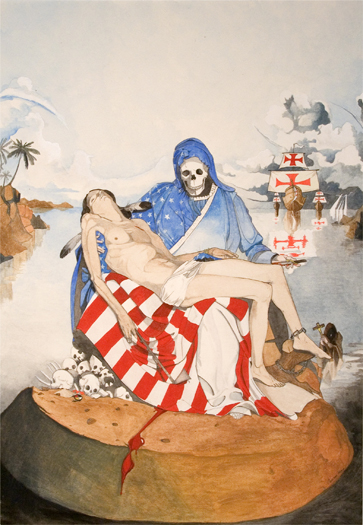|
Artwork by Carises Horn |
||
Burning Turtles, Singing Turtles
Gu daye wu, Gu daye wu, The Terrapin sang this medicine song and the pieces came together, but scars remain on his shell to this day. Both Eastern and Western Cherokee know this tale about the turtle, whose back was broken in a dozen places when he struck a rock after being thrown into the water. Variations exist in the Catawba, Creek, Omaha and Cheyenne tribes. Recorded by James Mooney in Myths of the Cherokee, it is also recorded in West Africa. In linguistics, the medicine song of the turtle is a "performative utterance": action described by the utterance is performed by the utterance itself. The turtle heals itself by singing a healing song. Among the most horrifying of recent headlines was that turtles were being burned alive. What does a turtle's death song sounds like? Rescuers have since been allowed to remove turtles before the burns, but there is no telling how many turtles were incinerated alive-rare turtles like the Kemp's Ridley, one of several turtle species already endangered, according to the Sea Turtle Restoration Project. The BP disaster (rightly termed "ecocide") merely compounds an already-fragile condition. Not yet covered by international law, ecocide is considered by some an international crime against peace, just as genocide and crimes against humanity (for more information, see www.thisisecocide.com). Cherokee language is likewise endangered. Thankfully, there are immersion classes for adults and even more importantly, for children. Language helps to carry culture. It is not the only thing, but it is an important thing. Just as the turtle is not the only animal affected by the ecocide, but is part of the whole. In the traditional stomp dance, women are the shell-shakers, wearing turtle shells-or sometimes milk can rattles-on their ankles. (For an exploration of Two-Spirits' traversal of this traditional gender role, see Qwo-Li Driskill's essay, Shaking Our Shells: Cherokee Two-Spirits Rebalancing the World.) If turtles disappeared then this tradition would be affected. I have never participated in a stomp dance-like many of Indian descent, I do not live within a tribal community, much less get to participate in ceremonial life. (My writing, in a small way, is an attempt to sew myself back together, to pick up lost stitches of my past and honor what little I know of what undocumented Cherokee blood has flowed into my family.) In Northern tribal myth, Turtle supports the earth on its back. A burning turtle thus symbolizes the world's demise in a conflagration of greed. A Cherokee elder once told me that turtle meat tasted of all other meats combined. This is fitting for a creature that encompasses the world. In other Cherokee myths, unwitting people mistake the turtle for a seat. This humorous touch is also a tool for learning: our self-absorption precludes us from noticing the effect of our actions. In another tale, again recorded by Mooney, a turtle becomes disgusted with the world and burrows to middle earth where he now lives in peace. Even there, would it hear the drill for oil? As reported in Mother Earth Journal, Anishinabe elder Dave Courchene of the Turtle Lodge opened the G8 World Religions Summit with a call for water ceremony: holding a bottle of clean water to our hearts, offer prayerful gratitude "... to all water of the Earth that has been affected and contaminated. Send your love to the water and to Mother Earth." I dream about turtles swimming close to shore in search of unpolluted water. If dreams are the collective sea of consciousness, then that is one place we are all joined, there and in prayers. Our tears are silent prayers and have some of the ocean's salt in them; there is something of the sea in all of us and being mostly water, we each long to join something greater than ourselves, just as all water flows toward the ocean. On a morning walk, I see four turtles sunning. The three smaller slide into the water at my approach, while the fourth larger cranes its head back as if to look at me before also entering the water. What wisdom in its gaze, what forbearance, as if it knows what has befallen its sisters and brothers, as if it senses my complicity, since my dependence on my car is dependence on oil-the very dependence from which BP and other companies-remember the Exxon Valedez? -profit. The turtles need our songs. Our songs of advocacy for-not the voiceless-but those with other than human voices. Our urging accountability for BP even as we take accountability for our own actions, since every thought and action sends positive or negative energy, good or bad medicine, into the world. (Masaru Emoto's The Hidden Messages in Water is a fascinating book documenting water's response to various conditions and human thoughts.) Just as every bead, every basket, every pot, every dance, every word made in the old ways creates renewal, so, too, every song and every prayer for the earth creates anew our connection to the world and its creatures. Our fate is tied to the backs of the turtles in the Gulf, just as our fingernails are made of the same keratin as turtle shells. Turtles who have survived the disaster have begun fighting their way through toxic waters to nest on shores littered with debris. In this act of survival they do what the Indigenous have always done: they are sewing their lives back together after the very fabric of their world has been rent. Scars remain as testament to the fracture and as warning against future disaster:
Gu daye wu, Gu daye wu,
|
||
|
|
||
